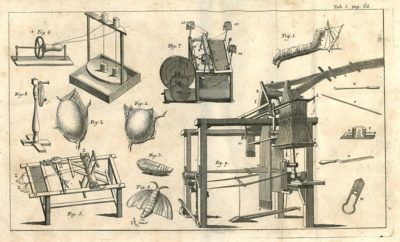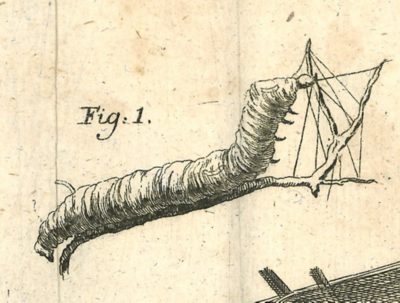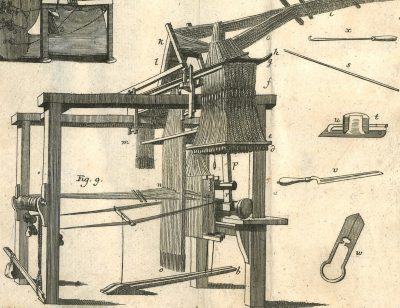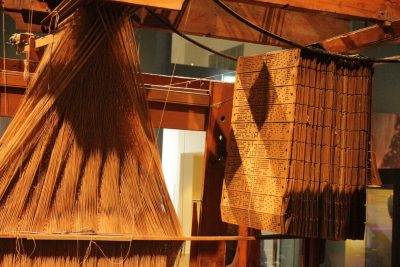Johann Samuel Halle: 'Die Seidenmanufaktur: Die elfte Abhandlung der Werkstätte der heutigen Künste.' (Berlin, 1762)
acquired in 2021
acquired in 2021
Beautifully bound in marbled paper, this compact treatise provides a portrait of the state of the art of silk production in Europe in the mid-18th century.
The author, Johann Samuel Halle (1727-1810), was an Enlightenment-era natural scientist and engraver. Acting under patronage of members of the Prussian Academy of Sciences, he set out to create a record of the techniques and technologies behind select prized goods, which led him to cover subjects such as gold and silver smithing, engraving, painting, and even wig making.
By the time that he wrote this work, the eleventh volume in the series, silk had already been an important and highly prized commodity for millennia. As Halle notes in a brief history of silk production at the beginning of the treatise, during the time of the Roman Emperor Marcus Aurelius a pound of silk could be exchanged for as much as a pound of gold.
Silk's production had been focused in China up until the late first millennium BC, by which point a trade route had become established, stretching West through Asia to the Mediterranean: the eponymous Silk Road. China maintained a monopoly, with the export of silk worms or their eggs an offence punishable by death. However, by the sixth century AD, worms and eggs had nonetheless been brought to Byzantium, and from there the industry spread to Italy, up through the Old Swiss Confederacy and beyond into Europe. Perhaps unbeknownst to Halle, silk production as he was describing it had reached its pre-industrial height and was about to undergo the convulsions of the industrial revolution.
Halle begins by providing an account of the history of silk production, continues to describe how to care for silk worms, and gives an insight into the requirements of the mulberry tree – their preferred foodstuff. His chief focus is, however, the process of turning the silk worm's cocoons into useable thread and the working of this thread into cloth. The text is accompanied by a text copperplate, depicting a scene from a workshop, while the foldout plate details the silk worm, associated production tools and a loom.
Interesting practical details leap out from the pages, such as the fact that 10 'lot' of eggs (1 lot was approximately 15g, so 150g of eggs) produced 150,000 to 200,000 silk worms, which required 300 'spinning rooms' (nurturing chambers) to produce enough cocoons for thirty pounds of silk.
Placed in a broader context, the volume importantly includes a description of producing cloth with a particular sort of silk loom that used pull chords in an intensely manual process to make patterns in the weave (see image below). Several decades later in 1804, this specific device was successfully automated by Joseph Marie Jacquard, with the movements of the chords determined by sequences of punch cards on a special rotating mechanism. The Jacquard Loom's impact was manifold. In the textile industry it set a precedent that continued to influence the designs of machines well into the 20th century, including those built by GF Machining Solutions company Rüti AG. Beyond the textile industry, Jacquard's work directly inspired Charles Babbage (1791-1881) to develop his analytical engine, one of the earliest computers. In such a way therefore, this work makes a very important addition to the library's earliest holdings on the origin and development of precision mechanical engineering and programmable technology.
 The volume (Photo: Iron Library)
The volume (Photo: Iron Library)
 The full engravings (Photo: Iron Library)
The full engravings (Photo: Iron Library)
 A silk worm (Photo: Iron Library)
A silk worm (Photo: Iron Library)
 Loom with pull chords (labelled 'f') (Photo: Iron Library)
Loom with pull chords (labelled 'f') (Photo: Iron Library)
 A Jacquard Loom showing punch cards, National Museum of Scotland (Photo: Stephen C. Dickson)
A Jacquard Loom showing punch cards, National Museum of Scotland (Photo: Stephen C. Dickson)